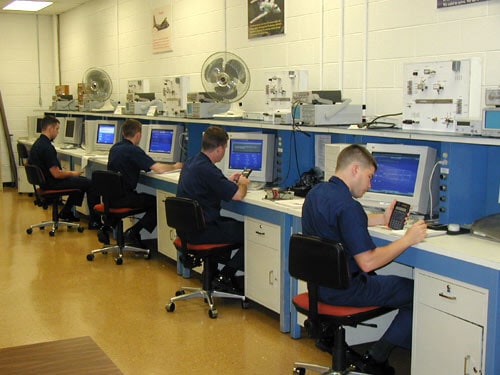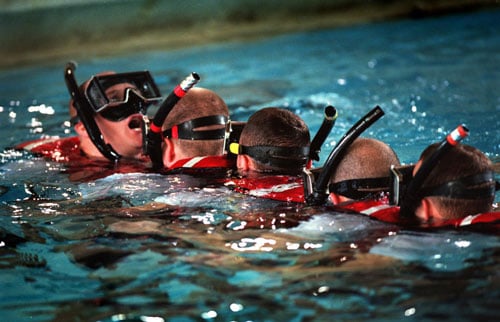Coast Guard Aviation Technical Training Center
In the early years of Coast Guard Aviation the US Coast Guard trained its enlisted aviation personnel at Navy schools. There was a restructuring of aviation enlisted ratings after World War II. In 1949 the initial aviation training “A” schools moved from San Diego to the Naval Training Center, Memphis, Tennessee. The Coast Guard continued to utilize the Navy schools with the exception of the Aviation Machinist’s Mate (AD) “A” school. The Coast Guard established its own AD “A” school at the Aircraft Repair and Supply Center (ARSC) in Elizabeth City, North Carolina. An AT “A” school was established at ARSC in 1964.
In 1972, Capt Les High, Chief of the Personnel Training and Procurement Division (G-PTP), Coast Guard Headquarters Washington, DC, commissioned an in-depth study of the aviation technical training needs of the Coast Guard. Aircraft and aircraft equipment had increasingly become Coast Guard specific. There also existed a difference in maintenance philosophies between the two services. The Navy taught the 3M system which the Coast Guard did not use and the “A” school graduates did not see a Coast Guard aircraft until they reached their first Air Station as an E4 Petty Officer. The study, under the direction of CDR George Krietemeyer, concluded there was a need for Coast Guard specific aviation technical training conducted at a common training site. The concept was approved by the Commandant and money was appropriated in FY 76 Budget. CDR Krietemeyer remained close to the project and became director of the newly created Aviation Management Branch at Coast Guard Headquarters.
Construction of the Coast Guard Aviation Technical Training Center (ATTC) began in July of 1976 at Elizabeth City, North Carolina. CDR Krietemeyer was transferred to AR&SC to oversee construction and operate the AD and AT schools. A selected cadre of AE and AM instructors was assigned to develop Coast Guard AE and AM curricula. The unit, was commissioned on August 4, 1978 with CDR Krietemeyer as Commanding officer. All of the “A” schools previously held at ARSC were moved to the new facilities and the newly developed Coast Guard AE and AM schools were established. In addition, selected advanced technical “C” school courses were also established.
The Aviation Survivalman (ASM) “A” School was added to the ATTC curriculum in 1980. Throughout the years, numerous “C” Schools offering advanced training in aviation maintenance have been added and removed at ATTC to keep pace with the changing aircraft and maintenance support requirements of Coast Guard aviation. The Coast Guard transitioned to Performance Based Training, which emphasized rapidly changing curricula to keep pace with technology.
In 1995 the Coast Guard undertook another service-wide study of the aviation maintenance requirements which resulted in a complete restructuring of the enlisted aviation workforce. In October 1998 ATTC began training and graduating petty officers in three newly created aviation ratings: Aviation Maintenance Technician (AMT), Aviation Survival Technician (AST), and Avionics Technician (AVT). A fine-tuning of aviation maintenance occurred in 2003 when some of the electrical maintenance responsibilities of the AMT were assigned to the AVT rating. These changes prompted a rating designation change of the AVT rating to AET; Avionics Electrical Technician. These advanced schools reflect the high degree of complexity associated with current aviation maintenance.
Since December 2003, aviation rates are represented in the “A” School curricula with courses of instruction approximately 20 weeks in duration. While at “A” School, students are introduced to a regimen of technical and personal challenges designed to develop their rate and leadership skills. Upon graduation students with a new aviation rating in either Aviation Maintenance Technician (AMT), or Aviation Survival Technician (AST), or Avionics Electrical Technician (AET) are assigned directly to active air stations. Students at “C” School are experienced technicians who receive in-depth training on specific components or systems as required to address particular needs of Coast Guard aviation.
Aviation Maintenance Technician (AMT)

Aviation Maintenance Technicians (AMT) are trained to perform ground handling and servicing of aircraft and conduct routine aircraft inspections and aviation administrative duties. AMTs inspect, service, maintain, troubleshoot, and repair aircraft engines, auxiliary power units, propellers, rotor systems, power train systems and associated airframe and systems specific electrical components. They also service, maintain, and repair aircraft fuselage, wings, rotor blades, fixed and movable flight control surfaces; aircraft bleed air, hydraulic and fuel systems. Additionally, AMTs perform flight duties in the following Aircrew Positions: Flight Engineer, Flight Mechanic, Loadmaster, Dropmaster, Sensor Systems Operator, and Basic Aircrewman. AMTs assigned to HH-65A Air Stations can expect shipboard deployments for various periods of time.
Avionics Electrical Technician (AET)

AETs inspect, service, maintain, and repair troubleshoot avionics systems that perform communications, navigation, collision avoidance, target acquisition, and automatic flight-control functions. In addition, they inspect, service, maintain, troubleshoot and repair aircraft batteries, AC and DC power generation, conversion and distribution systems, as well as the electrical control and indication functions of all airframe systems, including hydraulics, flight control, landing gear, fuel, environmental control, power plant, drive train, anti-ice, and fire detection. AETs perform ground handling and servicing of aircraft, and conduct routine aircraft inspections and aviation administrative duties. They will also fill aircrew positions such as navigator, flight mechanic, radio operator, sensor systems operator, and basic aircrewman. AETs assigned to HH-65 Air Stations can expect shipboard deployments for various periods of time.
Aviation Survival Technician (AST)

Aviation Survival Technicians perform ground handling and servicing of aircraft and conduct routine aircraft inspections and aviation administrative duties. ASTs inspect, service, maintain, troubleshoot, and repair cargo aerial delivery systems, drag parachute systems, aircraft oxygen systems, helicopter flotation systems, dewatering pumps, survival equipment for air-sea rescue kits and special purpose protective clothing. They also store aviation ordnance and pyrotechnic devices. ASTs provide all aircrew survival training to aviators such as swim tests, survival lectures and shallow water egress training. Aviation Survival Technicians function operationally as Helicopter Rescue Swimmers and Emergency Medical Technicians (EMT) Basic. ASTs may find themselves being deployed into a myriad of challenging rescues ranging from hurricanes and cliff rescues, to emergency medical evacuations from ships at sea. Updating of facilities in 2012 allowed for more realistic training preparing the AST for the challenges he/she will face as operational rescue swimmers. The new facilities simulate things such as high winds, roaring water and the sound of helicopter rotor blades and rotor wash effect. In addition rescue scenarios simulating inclement weather operations.
Following graduation from ATTC, ASTs must graduate from the Coast Guard Emergency Medical Technician (EMT) School in Petaluma, California prior to becoming fully qualified AST/Rescue Swimmers. Other aircrew positions include Dropmaster, Loadmaster, Sensor Systems Operator, and Basic Aircrewman. ASTs assigned to HH-65 Air Stations can expect shipboard deployments for various periods of time.
As a prerequisite to attending “A” school all prospective students are required to complete a four-month Airman program at an air station. “A” school courses vary from 16 to 20 weeks. Upon course completion, and if all other requirements are met, graduates are transferred to operational air stations as Third Class Petty Officers (E-4). ATTC “C” Schools provide advanced/specialized training for more experienced technicians. “C” School students receive in-depth training designed to address specific needs of the field. At present, ATTC provides five different AMT “C” School courses on specific airframes and power plants, as well as HH-60 and HH-65 helicopter Rotor-Tuner training. AET “C” Schools include basic Air Navigation and three airframe specific avionics system courses.
The training Center is composed of four modern structures that contain twenty classrooms, five maintenance/electronic labs, instructional aircraft and maintenance training units, engine, metal, composite classrooms. There are also state-of-the-art ‘Hot” mock-ups, a computer media center and swimmer training facilities. A staff of six officers, seventy enlisted and five civilians provide apprentice level (“A” School) and journeyman level (“C” School) training to nearly 700 of the Coast Guard’s aviation maintenance personnel yearly.
ATTC provides a number of additional training related services including analysis , design, development, and evaluation of resident and non-resident courses and the development of all service wide exams. These services support the Office of Aeronautical Engineering, the Office of Aviation Management and the Office of Training and Performance Consulting. Career development programs such as obtaining FAA Airframe and Power Plant (A&P) certificates are available. There are advanced education programs available whereby qualified enlisted personnel may obtain associate and baccalaureate degrees.
ATTC continuously evaluates the training needs of aviation personnel, examining the feasibility of hosting courses and providing training materials and other means to expand training capabilities and effectiveness.


